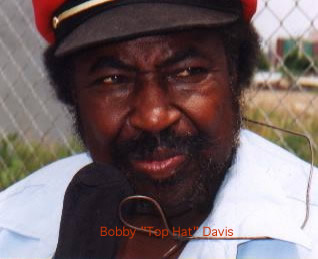|
|
|
The Gentrification Blues
By: Eric Schmidt
February 25, 2006
CHICAGO-The neighborhood where Chicago blues is said to have originated, Maxwell Street, has been gentrified beyond recognition, according to the Maxwell Street Historic Preservation Coalitions’ latest press release.
A place made famous by the likes of Muddy Waters, Little Walter, Daddy Stovepipe and Big Walter Horton in the 40s and 50s, where they would play for free, is now a University of Illinois, Chicago parking lot says the Maxwell Street Historic Preservation Coalition (M.S.H.P.C).
Bobby “Top Hat” Davis has been playing the blues on Maxwell Street since the 1950s. Davis is among the few original bluesmen to maintain the tradition of live blues on Maxwell Street almost every weekend. Like the old days, these impromptu jam sessions bring musicians together from all over to play on the historic street.

“I love this neighborhood,” says Davis. “This was an area that was welcome to everyone, which wasn’t the case for most of Chicago at the time. The music was down home just like the neighborhood.”
Aside from being a celebrated bluesman, Davis is also a Maxwell Street Coalition member.
“We want to keep the spirit of this place alive for the people of the world,” says Davis. “It’s important that future generations be able to come here and experience the birthplace of Chicago blues.”
But the cement has long since cracked on Maxwell Street with gentrification as the primary culprit, says the M.S.H.P.C. Where mom and pop shops once stood, corporate stores like Target and Borders have now take up residence. Record shops are replaced by Starbucks and affordable local eateries have become Noodles & Company.

Steve Balkin, former Vice President of the Maxwell Street Historic Preservation Coalition and Economics Professor at Roosevelt University, explains how Maxwell Street blues originated on the Mississippi Delta and migrated to Chicago.
“From Mississippi, it traveled through Memphis and settled in Chicago at the Maxwell Street Market, where in the 1940s, it became electrified and was given a strong backbeat,” he said. “This sound was developed at the Maxwell Street Market and local blues clubs became the principal source of musical employment for blues musicians just in from the South.”
Maxwell Street blues’ influences were widespread including the popular bands Cream, The Rolling Stones, The Yardbirds, Led Zeppelin and the Byrds. The Maxwell Street blues’ impact on the music scene would be forever cemented, according to the M.S.H.P.C website.
Maxwell Street was the heart of Chicago's black ghetto. New arrivals from the South as well as veterans of the local blues scene could gather in the open-air market, play their music, swap stories and find gigs in the neighborhood watering hole, said Balkin.
What made the music unique was its refusal to bow to popular music and become orthodox, said Balkin. Instead, Chicago blues or “Maxwell Street Blues,” as it was commonly referred to, was gritty, raw and dramatic. “Chicago blues contained a powerful voice and a defiant soul that captivated the music scene,” said Balkin.
So what’s happened to this historically rich area?
Lori Grove and Laura Kamedulski, M.S.H.P.C board members and authors of Chicago's Maxwell Street, Arcadia Publishing, 2002, blame Mayor Daley and the University of Illinois, Chicago, for the gentrification of Maxwell Street. The city built the Dan Ryan Expressway in 1962, effectively cutting off the eastern part of the street. The University took up residence here in 1965 and immediately made plans to destroy all of the old buildings that were a link to the past, say Grove and Kamedulski in their book.
Despite the region’s cultural significance, the University saw little reason to maintain the worn-down buildings and neighborhood, and the area was quickly transformed. Despite the action of some grass-roots activists, the locale was swarmed by rehabbers who have already taken over the historic town and turned it into a virtual strip mall.
“UIC don’t want us here,” says an agitated “Top Hat” Williams. “They’ve done all they can to rip the culture right out of this place. Tell me, how does destroying the memories of this historic area going to help the students of UIC?”
 Balkin says a culturally rich neighborhood would enhance the university experience for it’s students. “Maxwell Street can be a resource to UIC and the City of Chicago if it can be preserved and revitalized without changing its basic character, thus benefiting the university and preserving our local heritage,” says Balkin.
Balkin says a culturally rich neighborhood would enhance the university experience for it’s students. “Maxwell Street can be a resource to UIC and the City of Chicago if it can be preserved and revitalized without changing its basic character, thus benefiting the university and preserving our local heritage,” says Balkin.
Preserving Maxwell Street could have economic benefit from tourism dollars while recognizing the cultural significance of the area, according to the latest M.S.H.P.C press release.
“Much of the historic neighborhood had already been consumed and literally demolished because of UIC expansion,” says Balkin. “Much damage has been done already and part of our American legacy has been lost irrevocably.”
And so the music has all but stopped on Maxwell Street. The once bustling Sunday market where live music could be heard are now the sites of construction projects where historic buildings are torn down to make way for million dollar condominiums.
There is a “New Maxwell Street” that’s a few blocks from the original, but aside from the name, “New Maxwell Street” shares virtually nothing in common with the old one. It is now more of a Spanish flea market where salsa is the music of choice.
It appears that there is no more room for blues on the historic Maxwell Street, says “Top Hat” Davis despairingly.
“Since when did money become more important than our heritage,” asks Davis. “This city is known for three things: the buildings, the food, and the blues. If we don’t protect Maxwell Street, we’ll be losing a big piece of Chicago’s history forever."
LINKS: